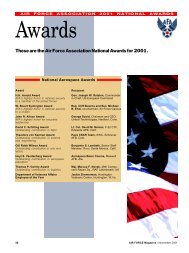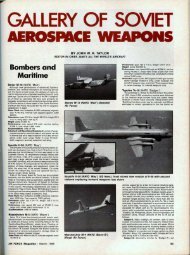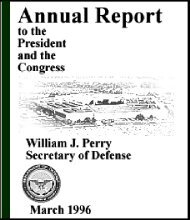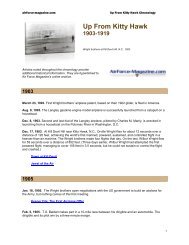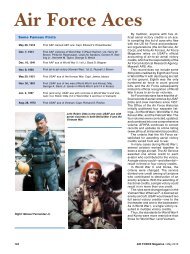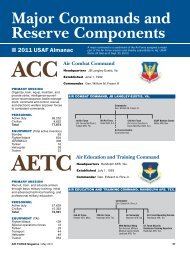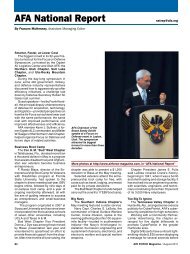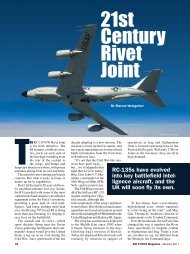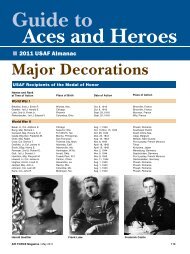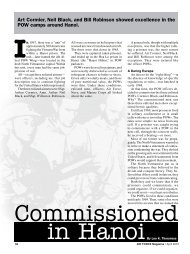US Air Forces in Europe supports the full range ... - Air Force Magazine
US Air Forces in Europe supports the full range ... - Air Force Magazine
US Air Forces in Europe supports the full range ... - Air Force Magazine
You also want an ePaper? Increase the reach of your titles
YUMPU automatically turns print PDFs into web optimized ePapers that Google loves.
<strong>Europe</strong>an<br />
Crossroads<br />
<strong>US</strong> <strong>Air</strong> <strong><strong>Force</strong>s</strong> <strong>in</strong> <strong>Europe</strong> <strong>supports</strong> <strong>the</strong> <strong>full</strong><br />
<strong>range</strong> of <strong>Air</strong> <strong>Force</strong> missions, and props<br />
up a falter<strong>in</strong>g NATO, but is no longer<br />
considered <strong>the</strong> tip of <strong>the</strong> spear.<br />
38<br />
By John A. Tirpak, Executive Editor<br />
<strong>US</strong> <strong>Air</strong> <strong><strong>Force</strong>s</strong> <strong>in</strong> <strong>Europe</strong> is<br />
struggl<strong>in</strong>g with its identity.<br />
Once <strong>the</strong> tip of America’s<br />
Cold War spear, stand<strong>in</strong>g<br />
ready with <strong>the</strong> very best aircraft to face<br />
down <strong>the</strong> Soviet Union, <strong>US</strong>AFE is now<br />
seek<strong>in</strong>g <strong>the</strong> right posture <strong>in</strong> a <strong>the</strong>ater<br />
where direct large-scale military threats<br />
are vague and allied partners seem to<br />
be disarm<strong>in</strong>g via budget cuts.<br />
Intentionally or not, <strong>the</strong> Pentagon has<br />
drawn <strong>the</strong> identity issue <strong>in</strong> high relief,<br />
downgrad<strong>in</strong>g <strong>the</strong> position of <strong>US</strong>AFE’s<br />
commander from a four-star billet to a<br />
three-star job, when <strong>the</strong> next boss takes<br />
over on a timetable still to be worked<br />
out. Allies could easily construe <strong>the</strong><br />
move as a sign that Wash<strong>in</strong>gton considers<br />
<strong>Europe</strong>an airpower less important<br />
than missions <strong>in</strong> o<strong>the</strong>r areas.<br />
Asked how allies have reacted to<br />
<strong>the</strong> news that <strong>the</strong> <strong>Air</strong> <strong>Force</strong>’s <strong>Europe</strong>an<br />
AIR FORCE Magaz<strong>in</strong>e / September 2011
<strong>US</strong>AF photo by MSgt. John E. Lasky<br />
<strong>US</strong>AF photo by SrA. Ethan Morgan<br />
component will soon be led by a threestar,<br />
<strong>US</strong>AFE commander Gen. Mark<br />
A. Welsh III said <strong>the</strong> move hasn’t created<br />
any obvious distress. The o<strong>the</strong>r<br />
NATO countries are preoccupied with<br />
<strong>the</strong> “thrash and turmoil” of <strong>the</strong>ir own<br />
economic difficulties.<br />
However, “<strong>the</strong> comment I get—k<strong>in</strong>d<br />
of a jok<strong>in</strong>g comment—is, ‘Are you<br />
los<strong>in</strong>g <strong>in</strong>terest <strong>in</strong> <strong>Europe</strong>?’ ” For <strong>the</strong><br />
allies’ part, he said, this is “a legitimate<br />
question.”<br />
As NATO moves to a s<strong>in</strong>gle air command,<br />
“it does create an <strong>in</strong>terest<strong>in</strong>g<br />
perspective from <strong>the</strong> NATO side,” Welsh<br />
noted. “Will a <strong>US</strong> three-star compete<br />
with o<strong>the</strong>r country four-stars” for <strong>the</strong><br />
Alliance air commander job? “It just<br />
rema<strong>in</strong>s to be seen,” he said.<br />
There are o<strong>the</strong>r h<strong>in</strong>ts that Wash<strong>in</strong>gton’s<br />
focus has shifted elsewhere. The<br />
<strong>Air</strong> <strong>Force</strong> has never sent its top-of-<strong>the</strong>l<strong>in</strong>e<br />
F-22s to <strong>Europe</strong> for a long visit,<br />
though it has sent <strong>the</strong>m on extended<br />
deployments to Japan and Guam and<br />
based <strong>the</strong>m <strong>in</strong> Hawaii. Likewise, <strong>US</strong>AF<br />
still has no firm plans to base F-35s <strong>in</strong><br />
<strong>Europe</strong>, although bases <strong>in</strong> England,<br />
Germany, and Italy that are currently<br />
home to A-10 and F-16 squadrons are<br />
logical dest<strong>in</strong>ations.<br />
To save money, <strong>the</strong> staffs of <strong>US</strong>AFE<br />
and <strong>Air</strong> <strong><strong>Force</strong>s</strong> Africa—<strong>the</strong> air component<br />
to <strong>US</strong> Africa Command—will be<br />
reduced and comb<strong>in</strong>ed. Third <strong>Air</strong> <strong>Force</strong>,<br />
<strong>US</strong>AFE’s operational component, will<br />
absorb AFRICOM’s17th <strong>Air</strong> <strong>Force</strong>,<br />
which will be <strong>in</strong>activated. For <strong>US</strong>AFE,<br />
<strong>the</strong>re’s “lots of pressure to create more<br />
efficiencies, figure out how to do <strong>the</strong> job<br />
for less money [and] fewer resources,”<br />
Welsh said <strong>in</strong> a June <strong>in</strong>terview.<br />
A few years ago, 17th <strong>Air</strong> <strong>Force</strong><br />
was activated to meet <strong>the</strong> needs of<br />
AFRICOM, to manage <strong>in</strong>terchanges<br />
with African air forces and supply<br />
airpower to AFRICOM’s commander.<br />
However, by <strong>the</strong> end of Fiscal 2012,<br />
17th <strong>Air</strong> <strong>Force</strong> will fold its flag and 3rd<br />
<strong>Air</strong> <strong>Force</strong> will aga<strong>in</strong> provide plann<strong>in</strong>g<br />
and assets to serve both cont<strong>in</strong>ents.<br />
AFRICOM doesn’t want to lose “<strong>the</strong><br />
momentum that <strong>the</strong>y’ve ga<strong>in</strong>ed” <strong>in</strong><br />
do<strong>in</strong>g partnership events with African<br />
countries, Welsh said. “We don’t want<br />
to lose it ei<strong>the</strong>r, so as 17th <strong>Air</strong> <strong>Force</strong> is<br />
folded <strong>in</strong>to our staff ... we need to ensure<br />
that we cont<strong>in</strong>ue to provide that same<br />
k<strong>in</strong>d of support to Africa Command.”<br />
With no additional assets to do<br />
that, though, choices must be made,<br />
Welsh said.<br />
Left: A <strong>US</strong>AFE KC-135 from RAF Mildenhall, UK, tops up an RAF Tornado. Below:<br />
A C-17 is prepped for load<strong>in</strong>g on <strong>the</strong> ramp at Ramste<strong>in</strong> AB, Germany. Ramste<strong>in</strong> is<br />
headquarters for <strong>US</strong>AFE.<br />
AIR FORCE Magaz<strong>in</strong>e / September 2011 39
<strong>US</strong>AF photo by A1C Desiree W. Esposito<br />
In Grafenwoehr, Germany, TSgt. Joel McPherson briefs TSgt. Steven Love (l) and SrA.<br />
Ian Johnson (r) on advanced shoot<strong>in</strong>g tactics dur<strong>in</strong>g Allied Strike, <strong>the</strong> <strong>US</strong> and NATO<br />
premier jo<strong>in</strong>t close air support exercise.<br />
“We are go<strong>in</strong>g to have to very clearly<br />
prioritize activity both <strong>in</strong> <strong>Europe</strong> and <strong>in</strong><br />
Africa,” he observed. He frankly admitted,<br />
“I don’t know if we can cont<strong>in</strong>ue<br />
... <strong>the</strong> same level of effort.” That will<br />
be dictated by <strong>US</strong>AFE’s future force<br />
structure, he said. Both command staffs<br />
will have to “clearly understand where<br />
we can place priority of effort—who we<br />
can support, and who we can’t, and why.”<br />
In cases where “both combatant<br />
commanders are very focused on a<br />
particular activity that <strong>in</strong>volves <strong>the</strong> same<br />
resources <strong>in</strong> <strong>the</strong> same time span,” and<br />
negotiations can’t produce a workable<br />
answer, “I guess ultimately <strong>the</strong> Jo<strong>in</strong>t<br />
Staff will be <strong>the</strong> decid<strong>in</strong>g body” on<br />
who gets priority. “But I don’t expect<br />
that to happen very often.”<br />
Adm. James G. Stavridis, head of<br />
<strong>US</strong> <strong>Europe</strong>an Command and NATO<br />
Supreme Allied Commander, <strong>Europe</strong>,<br />
has established three priorities for<br />
EUCOM—and thus <strong>US</strong>AFE—which<br />
Welsh summed up as: W<strong>in</strong> <strong>in</strong> Afghanistan,<br />
streng<strong>the</strong>n <strong>the</strong> NATO team, and<br />
shape <strong>the</strong> future of <strong>the</strong> Alliance.<br />
Given those priorities—and <strong>the</strong> absence<br />
of a Soviet-style threat—what is<br />
<strong>US</strong>AFE’s pr<strong>in</strong>cipal mission?<br />
“Build<strong>in</strong>g partnership and partner<br />
capacity,” Welsh said. “It is <strong>the</strong> ma<strong>in</strong>stream<br />
mission of <strong>the</strong> command—not<br />
just for <strong>US</strong>AFE, but all <strong>the</strong> components<br />
of EUCOM.”<br />
To that end, Welsh said, <strong>US</strong>AFE<br />
conducts between 1,700 and 1,900<br />
engagement events every year, both<br />
with<strong>in</strong> <strong>the</strong> NATO Alliance and with<br />
o<strong>the</strong>r countries, under <strong>the</strong> Partnership<br />
for Peace program. These <strong>range</strong> from<br />
40<br />
top-level military summits and major<br />
air exercises to delegations of one airman<br />
visit<strong>in</strong>g a Belgian squadron for a<br />
week’s “immersion.”<br />
“Streng<strong>the</strong>n<strong>in</strong>g <strong>the</strong> team” is a critical<br />
mission for <strong>US</strong>AFE.<br />
Bra<strong>in</strong>storm<strong>in</strong>g<br />
“The partners we have here <strong>in</strong> <strong>Europe</strong><br />
are arguably <strong>the</strong> strongest partners <strong>the</strong><br />
<strong>US</strong> has,” Welsh said. By help<strong>in</strong>g <strong>the</strong>m<br />
get stronger, it “gives us <strong>the</strong> ability<br />
to surge with capabilities we might<br />
not have resident <strong>in</strong> <strong>the</strong> <strong>US</strong> military.”<br />
More capability among <strong>the</strong> partners<br />
means less <strong>the</strong> <strong>US</strong> <strong>Air</strong> <strong>Force</strong> itself has<br />
to contribute.<br />
Welsh noted that some NATO allies—particularly<br />
among <strong>the</strong> smaller,<br />
newer members—have little to no air<br />
capability. However, <strong>the</strong>y make a strong<br />
effort to contribute with<strong>in</strong> <strong>the</strong>ir means.<br />
“Last year, we tra<strong>in</strong>ed 72 NATO<br />
JTACs,” or jo<strong>in</strong>t term<strong>in</strong>al attack controllers,<br />
Welsh said. This year that number<br />
will double. “Right now, <strong>the</strong>re are 214<br />
NATO JTACs <strong>in</strong> Afghanistan,” he noted.<br />
“Every one of those guys is a JTAC <strong>the</strong><br />
<strong>US</strong> doesn’t have to send.”<br />
When he came to <strong>the</strong> job late last<br />
year, he expected to see some allies<br />
“do<strong>in</strong>g everyth<strong>in</strong>g, some noth<strong>in</strong>g.” But<br />
he has been surprised by small countries<br />
“that don’t have a lot to give except<br />
<strong>the</strong>ir energy and <strong>the</strong>ir effort and <strong>the</strong>ir<br />
people. They’re all really committed.”<br />
In an earlier <strong>in</strong>terview, Welsh had<br />
<strong>in</strong>cluded two more priority items with<br />
Stavridis’ top three: “Look for creative<br />
solutions and nontraditional partnerships.”<br />
Creative solutions are a key to<br />
<strong>US</strong>AFE’s and NATO’s future. Partners<br />
are cutt<strong>in</strong>g <strong>the</strong>ir defense budgets significantly,<br />
and <strong>US</strong>AFE’s own resources<br />
will have to stretch to meet <strong>the</strong> needs<br />
of both EUCOM and AFRICOM.<br />
One idea that may well prove a model<br />
approach is called <strong>the</strong> Strategic <strong>Air</strong>lift<br />
Capability. Based at Papa AB, Hungary,<br />
<strong>the</strong> SAC is a cooperative effort by 12<br />
countries: 10 NATO partners, <strong>in</strong>clud<strong>in</strong>g<br />
<strong>the</strong> <strong>US</strong>, and two non-NATO members,<br />
Sweden and F<strong>in</strong>land. The organization<br />
owns three C-17 airlifters, flown and<br />
ma<strong>in</strong>ta<strong>in</strong>ed by all participants.<br />
The organization is not a NATO<br />
unit and doesn’t come under NATO’s<br />
cha<strong>in</strong> of command. However, a steer<strong>in</strong>g<br />
committee of partners chaired<br />
by a <strong>US</strong>AF general officer decides<br />
how <strong>the</strong> aircraft will be used, and<br />
how to apportion fly<strong>in</strong>g hours among<br />
<strong>the</strong> members. The SAC members all<br />
had a need to move people and large<br />
equipment long distances, to meet both<br />
NATO and <strong>in</strong>dependent requirements,<br />
but <strong>the</strong> purchase of C-17-like aircraft<br />
was beyond <strong>the</strong> means of most. By<br />
pool<strong>in</strong>g <strong>the</strong>ir resources and creat<strong>in</strong>g a<br />
jo<strong>in</strong>t operat<strong>in</strong>g entity, called <strong>the</strong> Heavy<br />
<strong>Air</strong>lift W<strong>in</strong>g, all were able to meet <strong>the</strong>ir<br />
needs by chipp<strong>in</strong>g <strong>in</strong> on <strong>the</strong> airplanes<br />
and divid<strong>in</strong>g fly<strong>in</strong>g time.<br />
Welsh said <strong>the</strong> <strong>US</strong>AFE staff is “bra<strong>in</strong>storm<strong>in</strong>g<br />
ways” to use <strong>the</strong> SAC as a<br />
model for o<strong>the</strong>r needed capabilities.<br />
One sp<strong>in</strong>off could be <strong>in</strong> remotely<br />
piloted aircraft, Welsh noted. <strong>US</strong>AFE<br />
is expect<strong>in</strong>g to acquire MQ-9 Reapers<br />
when operations with that aircraft w<strong>in</strong>d<br />
down <strong>in</strong> Afghanistan. O<strong>the</strong>r NATO<br />
allies are pursu<strong>in</strong>g <strong>the</strong>ir own RPA programs;<br />
Brita<strong>in</strong> and Italy have already<br />
bought <strong>the</strong>ir own Reapers. Us<strong>in</strong>g <strong>the</strong><br />
<strong>Air</strong> <strong>Force</strong>’s exist<strong>in</strong>g satellite communications<br />
and process<strong>in</strong>g, exploitation<br />
and dissem<strong>in</strong>ation assets, RPAs could<br />
be a pooled mission.<br />
One idea is to create an RPA center<br />
at Ramste<strong>in</strong> AB, Germany, where both<br />
<strong>US</strong>AF and partner air forces could<br />
develop “common architectures that<br />
allow you to share assets and sensor<br />
data,” Welsh observed. Partners with<br />
RPAs need more ref<strong>in</strong>ement of <strong>the</strong>ir<br />
RPA <strong>in</strong>frastructure, and “I th<strong>in</strong>k we<br />
can help [<strong>the</strong>m] build that.”<br />
Maj. Gen. Mark O. Schissler, <strong>the</strong>n<br />
director of plans, programs, and analyses<br />
for <strong>US</strong>AFE, said <strong>in</strong> a June <strong>in</strong>terview<br />
<strong>the</strong>re’s “no reason” why an RPA<br />
consortium couldn’t work.<br />
“ISR tends to be very expensive,” he<br />
noted, a pr<strong>in</strong>cipal reason NATO oper-<br />
AIR FORCE Magaz<strong>in</strong>e / September 2011
ates an AWACS program jo<strong>in</strong>tly. “No<br />
s<strong>in</strong>gle nation wanted to shoulder <strong>the</strong><br />
cost of that.” An ISR consortium would<br />
want <strong>the</strong> <strong>US</strong> to be a member, though,<br />
because “we have … <strong>the</strong> backbone of<br />
<strong>the</strong> ISR system. We already own that;<br />
it’s essentially <strong>in</strong> place.”<br />
Just as <strong>in</strong> <strong>the</strong> <strong>US</strong>, however, <strong>the</strong><br />
major obstacle to comb<strong>in</strong><strong>in</strong>g an RPA<br />
capability <strong>in</strong> <strong>Europe</strong> is how to <strong>in</strong>tegrate<br />
it with a congested commercial air<br />
traffic control system. In <strong>the</strong> <strong>US</strong>, FAA<br />
approval to operate Reapers is still <strong>in</strong><br />
discussion; it will take even longer <strong>in</strong><br />
<strong>Europe</strong>, Schissler said.<br />
Ano<strong>the</strong>r possible consortium approach<br />
to hardware would be <strong>in</strong> Baltic<br />
air polic<strong>in</strong>g, Welsh said.<br />
Latvia, Lithuania, and Estonia have<br />
no air arms of <strong>the</strong>ir own, are <strong>in</strong> NATO’s<br />
far nor<strong>the</strong>ast, and clearly remember <strong>the</strong><br />
decades <strong>the</strong>y spent forcibly absorbed<br />
<strong>in</strong>to <strong>the</strong> Soviet Union. The Baltic states<br />
have relied on NATO partners to perform<br />
air sovereignty patrols s<strong>in</strong>ce 2004.<br />
The three countries do have pilots,<br />
however.<br />
“In my NATO hat, we’ve looked at<br />
… [whe<strong>the</strong>r] we can buy surplus fighters<br />
from somewhere, tra<strong>in</strong> a coalition,<br />
… a squadron, to live and operate <strong>in</strong><br />
<strong>the</strong> Baltics and do <strong>the</strong> air polic<strong>in</strong>g<br />
<strong>full</strong> time,” Welsh said. That would be<br />
an improvement over <strong>US</strong>AF or o<strong>the</strong>r<br />
member air arms “rotat<strong>in</strong>g squadrons<br />
<strong>in</strong> for three or six months at a time.”<br />
Such a consortium would “want to<br />
pick an airplane that many countries<br />
42<br />
Eyes and Ears Over Libya<br />
By June, <strong>the</strong> <strong>Air</strong> <strong>Force</strong>’s role support<strong>in</strong>g Operation Unified Protector, <strong>the</strong><br />
NATO mission to defend civilians <strong>in</strong> Libya’s civil war, had switched away from<br />
direct attack to that of central support element. <strong>US</strong> <strong>Air</strong> <strong><strong>Force</strong>s</strong> <strong>in</strong> <strong>Europe</strong> was<br />
provid<strong>in</strong>g “a lot of <strong>the</strong> key enablers,” said Gen. Mark A. Welsh III, <strong>US</strong>AFE<br />
commander. These <strong>in</strong>clude tankers, command and control, <strong>in</strong>telligence, surveillance,<br />
and reconnaissance assets, and o<strong>the</strong>r capabilities and capacities<br />
unique quantitatively to <strong>the</strong> United States.<br />
Is <strong>the</strong> Libya mission a stra<strong>in</strong> on <strong>US</strong>AFE, which is already heavily support<strong>in</strong>g<br />
Afghanistan operations?<br />
“I th<strong>in</strong>k everyth<strong>in</strong>g is a stra<strong>in</strong>,” Welsh replied. “Everybody is busy, … but<br />
it’s also what we do. … It’s why we have an <strong>Air</strong> <strong>Force</strong>; it’s why we’re tra<strong>in</strong>ed.”<br />
However, when asked how long <strong>US</strong>AFE can cont<strong>in</strong>ue at <strong>the</strong> pace it’s on,<br />
Welsh said, “It’s all a question of resources. It depends on <strong>the</strong> priorities<br />
of <strong>the</strong> nation. If it’s a high enough priority to <strong>the</strong> nation, we can susta<strong>in</strong> it.”<br />
are fly<strong>in</strong>g, so <strong>the</strong>y could use crews<br />
from many countries.” He decl<strong>in</strong>ed to<br />
nom<strong>in</strong>ate an airplane, but more NATO<br />
countries fly <strong>the</strong> F-16 than any o<strong>the</strong>r<br />
combat type.<br />
Build<strong>in</strong>g a Bridge<br />
There are “a lot of questions <strong>in</strong>volved<br />
<strong>in</strong> this,” Welsh admitted—such as who<br />
would buy <strong>the</strong> airplanes, how <strong>the</strong> operations<br />
and ma<strong>in</strong>tenance costs would be<br />
shared, and “who’s go<strong>in</strong>g to manage<br />
<strong>the</strong> airfield.”<br />
Schissler agreed that a fighter consortium<br />
poses some unique and thorny<br />
problems.<br />
“It’s a little easier to th<strong>in</strong>k about a<br />
consortium do<strong>in</strong>g airlift than it is about<br />
do<strong>in</strong>g offensive combat missions,” he<br />
said. It is “hard to share” <strong>the</strong> authority<br />
for order<strong>in</strong>g an attack among 12<br />
nations. There would have to be “extensive<br />
additional agreements about<br />
who’s got weapons release authority<br />
and th<strong>in</strong>gs like that.” Such a deal would<br />
be arduous to negotiate, he said.<br />
“That doesn’t mean it can’t be<br />
done, but it’s an additional challenge.”<br />
Tactical airlift could follow a model<br />
almost exactly like <strong>the</strong> SAC. Such an<br />
approach would be an extremely useful<br />
“bridge” for certa<strong>in</strong> countries whose<br />
current tactical airlifters are almost out<br />
of useful life and that have seen delays<br />
<strong>in</strong> gett<strong>in</strong>g new A400s, built by EADS.<br />
<strong>Europe</strong>an partners <strong>in</strong> NATO have<br />
three ma<strong>in</strong> th<strong>in</strong>gs <strong>the</strong>y are anxious to<br />
learn from <strong>the</strong> <strong>US</strong>.<br />
One is general tactics, techniques,<br />
and procedures, particularly with regard<br />
to “national sovereignty, airspace<br />
protection,” Schissler said.<br />
A C-17 taxis to <strong>the</strong> crowded ramp at Ramste<strong>in</strong> AB, Germany. The base is a critical<br />
waypo<strong>in</strong>t for people and cargo mov<strong>in</strong>g to and from Afghanistan.<br />
AIR FORCE Magaz<strong>in</strong>e / September 2011<br />
Staff photo by John A. Tirpak
Second is how <strong>US</strong>AF does aeromedical<br />
evacuation.<br />
“Our system is recognized as be<strong>in</strong>g<br />
… successful” at gett<strong>in</strong>g <strong>in</strong>jured people<br />
rapidly out of <strong>the</strong> combat zone and back<br />
to <strong>full</strong>-capability care, he said. Allies<br />
have seen it work not just for American<br />
personnel, but for <strong>the</strong>ir own <strong>in</strong>jured<br />
who have been transported by <strong>US</strong>AF.<br />
“Most of <strong>the</strong>m don’t possess that<br />
and <strong>the</strong>y <strong>in</strong>vited us to show <strong>the</strong>m our<br />
system, our people, our equipment.”<br />
F<strong>in</strong>ally, allies—particularly those<br />
<strong>in</strong> <strong>the</strong> East—are <strong>in</strong>terested <strong>in</strong> how<br />
<strong>US</strong>AF manages logistics and aircraft<br />
ma<strong>in</strong>tenance. Schissler said <strong>the</strong> legacy<br />
Soviet-style “push” system sends parts<br />
as <strong>the</strong>y are available, not necessarily<br />
when required. The American model<br />
is a “pull” system, <strong>in</strong> which parts are<br />
requested when needed.<br />
“We f<strong>in</strong>d it to be more efficient, and<br />
it gives us a better mission reliability<br />
rate.” He expla<strong>in</strong>ed that “if you’re wait<strong>in</strong>g<br />
for <strong>the</strong> ‘push’ and it doesn’t come,<br />
…your jet’s always down.”<br />
Welsh also anticipates a central role<br />
for <strong>US</strong>AFE <strong>in</strong> <strong>the</strong> <strong>Europe</strong>an missile<br />
defense mission.<br />
“One of <strong>the</strong> th<strong>in</strong>gs <strong>the</strong> <strong>Air</strong> <strong>Force</strong><br />
br<strong>in</strong>gs to [a] fight is <strong>the</strong> ability to command<br />
and control on a <strong>the</strong>ater level,”<br />
Welsh said. The function of provid<strong>in</strong>g<br />
C2 to missile defense architecture<br />
isn’t much different from <strong>the</strong> “k<strong>in</strong>d<br />
44<br />
The Base as a Weapon System<br />
of command and control necessary to<br />
command big air operations across <strong>the</strong><br />
breadth of a <strong>the</strong>ater. Missile defense fits<br />
very neatly <strong>in</strong>to that construct.”<br />
While <strong>the</strong> Army and Navy have<br />
more extensive experience with “<strong>the</strong><br />
tactical end of that bus<strong>in</strong>ess,” Welsh<br />
said <strong>US</strong>AFE’s air operations center<br />
will be <strong>the</strong> ideal place to manage missile<br />
defense, as it has pipes com<strong>in</strong>g<br />
<strong>in</strong> from a variety of space-based and<br />
ground-based sensors that can provide<br />
Ramste<strong>in</strong> AB, Germany, is headquarters to <strong>US</strong> <strong>Air</strong> <strong><strong>Force</strong>s</strong> <strong>in</strong> <strong>Europe</strong>, but<br />
<strong>the</strong> base should more accurately be regarded as a weapon system, asserted<br />
Brig. Gen. Mark C. Dillon, commander of <strong>the</strong> 86th W<strong>in</strong>g.<br />
The base <strong>in</strong> southwestern Germany is constantly transited by <strong>Air</strong> Mobility<br />
Command “heavies” transferr<strong>in</strong>g cargo and passengers to and from<br />
Afghanistan and o<strong>the</strong>r <strong>US</strong> Central Command locations. On a typical day <strong>in</strong><br />
June, Ramste<strong>in</strong>’s ramp bulged with four C-5s and 12 C-17s, as well as its<br />
own 12 C-130J tactical transports, two large charter aircraft, three KC-135<br />
tankers, and an array of resident VIP transports.<br />
The base also hosts air operations centers for both <strong>US</strong>AFE and <strong>US</strong> <strong>Air</strong><br />
<strong><strong>Force</strong>s</strong> Africa, <strong>the</strong> air component of <strong>US</strong> Africa Command.<br />
Nearby Landstuhl hospital is <strong>the</strong> way station for <strong>in</strong>jured <strong>US</strong> troops airlifted<br />
from Afghanistan. Regular flights br<strong>in</strong>g <strong>the</strong> <strong>in</strong>jured to Ramste<strong>in</strong> for care at<br />
Landstuhl; those with more serious <strong>in</strong>juries are rapidly moved Stateside.<br />
Security forces at Ramste<strong>in</strong> give a refresher course to airmen be<strong>in</strong>g sent to<br />
Afghanistan <strong>in</strong> ground assignments “outside <strong>the</strong> wire.” The week-long course<br />
refamiliarizes <strong>the</strong> airmen with checkpo<strong>in</strong>t procedures, convoys, small-arms<br />
tactics, spott<strong>in</strong>g improvised explosive devices, and o<strong>the</strong>r combat skills.<br />
Ramste<strong>in</strong> offers a one-of-a-k<strong>in</strong>d “decompression” program called “Combat<br />
Bridge,” designed to prepare airmen return<strong>in</strong>g from Afghanistan to cope with<br />
<strong>the</strong> unexpected pressures and difficulties of return<strong>in</strong>g to home life.<br />
In addition to base support functions, Ramste<strong>in</strong> is also a key storage area<br />
for munitions—important dur<strong>in</strong>g <strong>the</strong> recent Libyan operations, Dillon noted.<br />
It hosts a construction organization that travels around <strong>US</strong>AFE and nearby<br />
areas, provid<strong>in</strong>g unique services such as ma<strong>in</strong>tenance and repair of runway<br />
arrest<strong>in</strong>g gear. The base also is home to a cont<strong>in</strong>gency response group that<br />
can set up expeditionary base communications and networks.<br />
Soldiers and airmen unload military vehicles from a Strategic <strong>Air</strong>lift Capability<br />
consortium C-17 at an airfield <strong>in</strong> Lithuania. SAC, which comprises members from 12<br />
countries, owns three C-17 Globemaster III aircraft.<br />
data “from early warn<strong>in</strong>g to potential<br />
impact sites, to def<strong>in</strong>e and ref<strong>in</strong>e target<br />
areas, to allow some of <strong>the</strong> o<strong>the</strong>r pillars<br />
of missile defense to operate.”<br />
Given that missile defense is a new<br />
mission, does <strong>US</strong>AFE need more people<br />
to do <strong>the</strong> job? Schissler said, “I’m really<br />
reluctant to say we’ll need more people<br />
because that’s someth<strong>in</strong>g no one wants<br />
to hear.” He said <strong>US</strong>AFE hasn’t “sized”<br />
<strong>the</strong> mission yet, but “it will certa<strong>in</strong>ly<br />
be an additional task to what we do <strong>in</strong><br />
<strong>Europe</strong> and <strong>US</strong>AFE.”<br />
<strong>US</strong>AFE is do<strong>in</strong>g more “expeditionary”<br />
work with<strong>in</strong> <strong>the</strong> Alliance, and not<br />
just to Afghanistan. Command airmen<br />
regularly go on rotational trips to<br />
Bulgaria and Romania—“two-week<br />
trips, mostly,” Schissler noted. The <strong>Air</strong><br />
National Guard also does it through <strong>the</strong><br />
Partnership for Peace program.<br />
Such excursions are usually to take<br />
advantage of what Schissler described<br />
as excellent tra<strong>in</strong><strong>in</strong>g <strong>range</strong>s <strong>in</strong> <strong>the</strong> eastern<br />
region of NATO.<br />
“Those countries”—he <strong>in</strong>cluded Poland<br />
<strong>in</strong> <strong>the</strong> group—“offer us really superb<br />
airspace to tra<strong>in</strong> <strong>in</strong>. They have way better<br />
<strong>range</strong>s than we can get <strong>in</strong> some of <strong>the</strong><br />
countries we currently operate <strong>in</strong>.”<br />
Range access and limits on low-level<br />
fly<strong>in</strong>g <strong>in</strong> particular have been Alliance<br />
irritants for decades. Now, countries<br />
such as Brita<strong>in</strong> and Germany don’t<br />
allow such tra<strong>in</strong><strong>in</strong>g flights at all. To<br />
ma<strong>in</strong>ta<strong>in</strong> proficiency, <strong>US</strong>AFE pilots<br />
must ei<strong>the</strong>r go back to <strong>the</strong> <strong>US</strong> to participate<br />
<strong>in</strong> Red Flag exercises or go to<br />
<strong>the</strong> former Eastern Bloc.<br />
“Sometimes, price comes <strong>in</strong>to play,”<br />
Schissler said. Some countries “want<br />
AIR FORCE Magaz<strong>in</strong>e / September 2011<br />
<strong>US</strong>AF photo by TSgt. Wayne Clark
an exorbitant price to operate <strong>the</strong>re<br />
because we’re America.” Frequently,<br />
<strong>the</strong> cost avoidance of journey<strong>in</strong>g back<br />
to <strong>the</strong> States for tra<strong>in</strong><strong>in</strong>g makes <strong>the</strong><br />
payment worthwhile. Under a recent<br />
agreement, <strong>the</strong> <strong>Air</strong> <strong>Force</strong> will, on a<br />
rotational basis, operate some of its<br />
F-16s and C-130s at two Polish bases.<br />
The aircraft will come from <strong>US</strong>AFE,<br />
<strong>the</strong> Guard, and <strong>the</strong> Reserve.<br />
“Two-week rotations happen to<br />
fit very well with [<strong>the</strong> reserve components]<br />
if we give <strong>the</strong>m good plann<strong>in</strong>g,”<br />
Schissler noted. The program is<br />
designed to improve <strong>in</strong>teroperability<br />
between Poland and <strong>the</strong> <strong>US</strong>, and NATO<br />
broadly.<br />
One of <strong>the</strong> biggest challenges fac<strong>in</strong>g<br />
<strong>US</strong>AFE is major reductions <strong>in</strong> defense<br />
budgets of allies.<br />
Every nation has to make its own decisions<br />
about what it will cut, Schissler<br />
said, but “if everyone reduces fighters,<br />
are we go<strong>in</strong>g to have <strong>the</strong> fighter force<br />
structure that we want <strong>in</strong> NATO … collectively?”<br />
He said all <strong>the</strong> nations th<strong>in</strong>k<br />
<strong>the</strong>ir overhead is too large and “<strong>the</strong>y’re<br />
go<strong>in</strong>g to reduce that by, notionally, about<br />
20 percent.” Staffs are set to come down<br />
<strong>the</strong> same amount, he predicted. “But<br />
we have to take a m<strong>in</strong>ute and measure<br />
what we have left. And when it doesn’t<br />
meet our needs—not American needs,<br />
but NATO needs,” he said, “<strong>the</strong>n we<br />
have to adjust.”<br />
Schissler said his biggest concern<br />
about <strong>US</strong>AFE is that, <strong>in</strong> <strong>the</strong> zeal to<br />
reduce costs, <strong>the</strong> <strong>US</strong> might take what<br />
he called a “CON<strong>US</strong>-centric” view and<br />
eventually cease to properly ma<strong>in</strong>ta<strong>in</strong><br />
An RAF Reaper lands at Kandahar<br />
<strong>Air</strong>field, Afghanistan.<br />
46<br />
Gates’ Warn<strong>in</strong>g to <strong>Europe</strong><br />
NATO is flirt<strong>in</strong>g with irrelevancy if it doesn’t properly fund and size its military<br />
forces, Defense Secretary Robert M. Gates cautioned <strong>in</strong> June, before<br />
stepp<strong>in</strong>g down.<br />
Gates, <strong>in</strong> a part<strong>in</strong>g shot to fellow NATO defense m<strong>in</strong>isters at a meet<strong>in</strong>g<br />
<strong>in</strong> Brussels, Belgium, noted <strong>the</strong> <strong>US</strong> military now accounts for more than<br />
75 percent of NATO defense spend<strong>in</strong>g, up from a long-term average of 50<br />
percent, he said.<br />
NATO’s <strong>Europe</strong>an countries are cutt<strong>in</strong>g <strong>the</strong>ir defense budgets, and like <strong>the</strong><br />
<strong>US</strong>, are see<strong>in</strong>g more of <strong>the</strong>ir defense dollars go to personnel costs ra<strong>the</strong>r<br />
than procurement.<br />
For example, Germany—<strong>US</strong>AFE’s host for several bases and thousands<br />
of <strong>US</strong> military personnel—plans defense cuts of 25 percent by 2015, <strong>the</strong><br />
largest of any NATO member. Germany is also convert<strong>in</strong>g from a conscript<br />
force to volunteer military, mean<strong>in</strong>g it will likely have to spend more to attract<br />
and reta<strong>in</strong> qualified personnel.<br />
Elsewhere, Belgium and Italy are look<strong>in</strong>g at 10 percent reductions by 2012<br />
and 2014, respectively. Denmark and Brita<strong>in</strong> are reduc<strong>in</strong>g defense by about<br />
seven percent over <strong>the</strong> next few years. France, hav<strong>in</strong>g cut three percent<br />
already, is look<strong>in</strong>g to go deeper. Spa<strong>in</strong> cut 10 percent last year.<br />
One practical consequence of <strong>the</strong> ongo<strong>in</strong>g defense spend<strong>in</strong>g cuts is that<br />
<strong>Europe</strong>an NATO partners began runn<strong>in</strong>g out of munitions just 11 weeks <strong>in</strong>to<br />
<strong>the</strong> Libyan operation, Gates said, forc<strong>in</strong>g <strong>the</strong> <strong>US</strong> to “make up <strong>the</strong> difference.”<br />
NATO has turned <strong>in</strong>to a “two-tiered Alliance,” Gates asserted, made up of<br />
those who like to do “soft” tasks such as peacekeep<strong>in</strong>g and humanitarian<br />
relief missions, and those will<strong>in</strong>g to do “hard” tasks like combat. Those <strong>in</strong> <strong>the</strong><br />
first group have <strong>the</strong> benefits of NATO membership “but don’t want to share<br />
<strong>the</strong> risks and <strong>the</strong> costs.”<br />
The American taxpayer has a “dw<strong>in</strong>dl<strong>in</strong>g appetite and patience” to spend<br />
lavishly “on behalf of nations that are apparently unwill<strong>in</strong>g to devote <strong>the</strong><br />
necessary resources” to do <strong>the</strong>ir fair share and be “capable partners <strong>in</strong> <strong>the</strong>ir<br />
own defense,” Gates warned.<br />
Just five of 28 NATO countries meet <strong>the</strong> Alliance benchmark of spend<strong>in</strong>g<br />
two percent of GDP on <strong>the</strong>ir militaries, he said.<br />
<strong>the</strong> relationships, equipment, and<br />
forces <strong>in</strong> <strong>Europe</strong>.<br />
“The k<strong>in</strong>d of access and <strong>the</strong> k<strong>in</strong>d of<br />
relationships we have with partners here<br />
require regular ma<strong>in</strong>tenance,” he said.<br />
The United States should not assume<br />
that <strong>in</strong> six months or a year <strong>the</strong> <strong>Air</strong> <strong>Force</strong><br />
can fly back to a base <strong>in</strong> <strong>Europe</strong> and set<br />
up an expeditionary operation “if we’ve<br />
been absent from <strong>the</strong>re, completely.” n<br />
AIR FORCE Magaz<strong>in</strong>e / September 2011<br />
RAF image by Cpl. Steve Follows


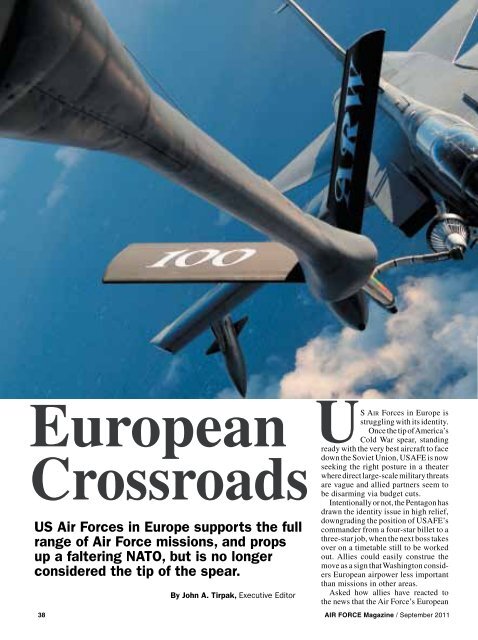
![[PDF] Foulois - Air Force Magazine](https://img.yumpu.com/13391007/1/190x253/pdf-foulois-air-force-magazine.jpg?quality=85)


